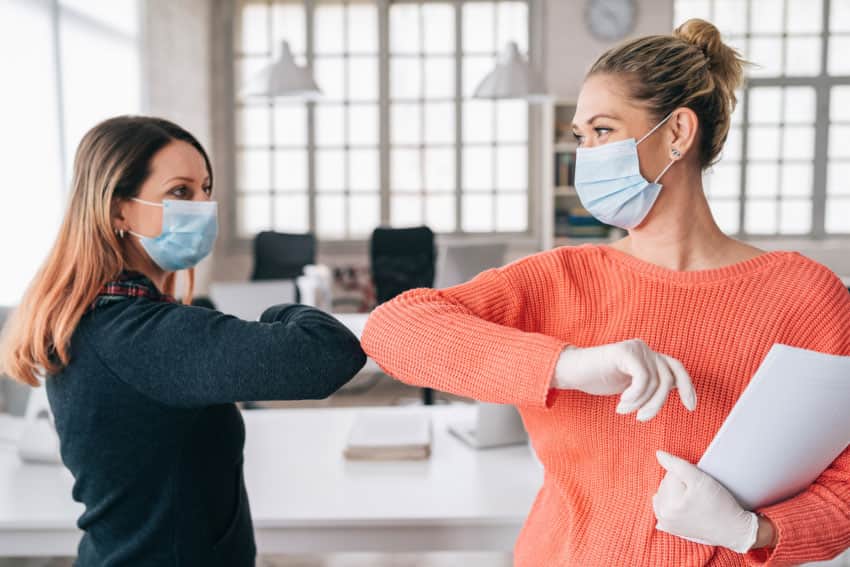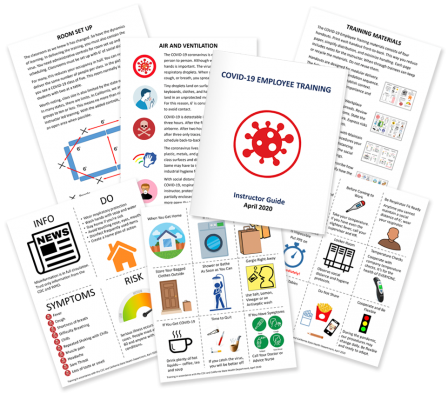COVID-19 employee training and PPE are core to sustainable operations.
Workers must protect themselves throughout the pandemic. With the goal to stay healthy and open, what should you do? Without a COVID-19 vaccine, layers of protection are needed. By itself, not one control can prevent infection. By applying multiple controls, you protect your organization.
Subsequently, you also prevent employees from spreading the virus. For this reason, employee training is key to sustainable operations. Moreover, PPE protects your from coronavirus and elevates industrial hygiene. As part of your COVID-19 employee training, require PPE and controls.
CAP OR HAIR PROTECTION
Presently, no studies exist on how long coronavirus lives on hair. Research shows COVID-19 lives 24 hours or longer on skin. Let’s assume the same for hair. On the job, cover your head. Wash your hair once you go home. Above all, do not risk infecting those you shelter with.
FACE MASKS AND RESPIRATORY PROTECTION
National Academy of Sciences research shows normal speech causes airborne coronavirus transmission. When you speak loudly the virus suspends in aerosol “micro-droplets.†Face masks do not guarantee you won’t be infected. When worn correctly, face masks do protect you from direct aerosol contact. Masks also remind you to not touch your mouth and nose. If you are asymptomatic, maks protect others from your aerosol droplets. For every COVID-19 employee training plan, respiratory protection must be mandatory.
GLOVES
Unfortunately, gloves are an imperfect form of protection. For this reason, they are as good as the person wearing them. They also become contaminated too so wash them just like your hands. Gloves act as a signal to not touch your face. They prevent direct contact when material handling. Above all, follow CDC guidelines when removing gloves to avoid cross-contamination.
PROTECTIVE COVERALLS
Currently, the CDC and OSHA offer no coverall guidelines for COVID-19 protection. Coveralls may be needed for transporting patients and decontamination disinfection. In high risk activities wear outer protective clothing or a Tyvek suit. This level of protection is needed for first responders and high-risk employees.
SAFETY GLASSES
Safety glasses and goggles prevent you from touching your eyes. When an infected person coughs or talks, they block virus spray. Although droplets mostly enter your nose or mouth, they also infect eyes. If you wear glasses, the virus can travel through the sides. For this reason, safety goggles offer a stronger defense.
SAFETY SHIELDS
Face shields also prevent you from touching your face. They can be reused and easily washed or disinfected. Face shields can reduce viral exposure by 96% according to studies. Face shields are an important component for health care workers. They are also necessary when social distance cannot be maintained.
No one form of PPE can protect you against COVID-19. It’s the layering of controls and signage that reduce risks. With each control, you elevate your protection. During the pandemic, do ongoing hazard assessment for tasks you perform. Part of your COVID-19 employee training involves determining PPE for every task. Being so highly contagious, the more controls you use the better.
To prevent COVID-19 in the workplace, face masks make a difference. Get your organization ready with our COVID-19 Employee Training materials and Instructor Guide. Set up for social distance, ventilation, masks and PPE. Leverage single-use training materials. Prevention, hygiene, hand washing and PPE. It’s all included! Print and you’re— Ready to go!


